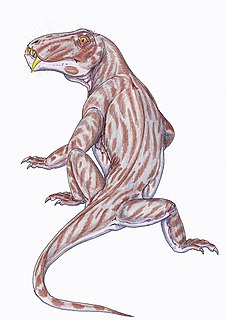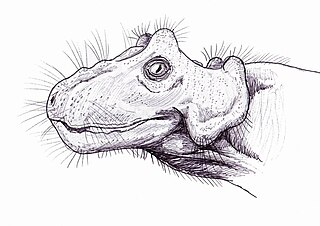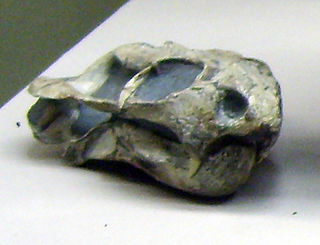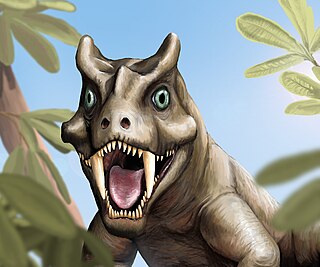
Biarmosuchia is an extinct clade of non-mammalian synapsids from the Permian. Biarmosuchians are the most basal group of the therapsids. They were moderately-sized, lightly-built carnivores, intermediate in form between basal sphenacodont "pelycosaurs" and more advanced therapsids. Biarmosuchians were rare components of Permian ecosystems, and the majority of species belong to the clade Burnetiamorpha, which are characterized by elaborate cranial ornamentation.

Ericiolacerta is an extinct genus of small therocephalian therapsids from the early Triassic of South Africa and Antarctica. It was around 20 centimetres (7.9 in) in length, with long limbs and relatively small teeth. It probably ate insects and other small invertebrates.

Eodicynodon is an extinct genus of dicynodont therapsids, a highly diverse group of herbivorous synapsids that were widespread during the middle-late Permian and early Triassic. As its name suggests, Eodicynodon is the oldest and most primitive dicynodont yet identified, ranging from the middle to late Permian and possessing a mix of ancestral Anomodont/therapsid features and derived dicynodont synapomorphies.

Anomocephalus is an extinct genus of primitive anomodonts and belongs to the clade Anomocephaloidea. The name is said to be derived from the Greek word anomos meaning lawless and cephalos meaning head. The proper word for head in Greek is however κεφαλή (kephalē). It is primitive in that it retains a complete set of teeth in both jaws, in contrast to its descendants, the dicynodonts, whose dentition is reduced to only a single pair of tusks, with their jaws covered by a horny beak similar to that of a modern tortoise. However, they are in no way closely related.

Australosyodon is an extinct genus of dinocephalian therapsids from the middle Permian of South Africa. The first fossil was discovered in the 1980s near the village of Prince Albert Road in the Karoo region of South Africa.

Lemurosaurus is a genus of extinct biarmosuchian therapsids from the Late Permian of South Africa. The generic epithet Lemursaurus is a mix of Latin, lemures “Ghosts, sprits”, and Greek, sauros, “lizard”. Lemurosaurus is easily identifiable by its prominent eye crests, and large eyes. The name Lemurosaurus pricei was coined by paleontologist Robert Broom in 1949, based on a single small crushed skull, measured at approximately 86 millimeters in length, found on the Dorsfontein farm in Graff-Reinet. To date, only two skulls of the Lemurosaurus have been discovered, so body size is unknown. The second larger, more intact, skull was found in 1974 by a team from the National Museum in Bloemfontein.

Burnetia is an extinct genus of biarmosuchian therapsids in the family Burnetiidae, from the Late Permian of South Africa. Burnetia is known so far from a single holotype skull lacking the lower jaws described by South African paleontologist Robert Broom in 1923. Due to erosion and dorsoventral crushing, features of the skull are hard to interpret. Stutural lines are further distorted by the unusual shape of the skull roof, including many bosses and protuberances.

Paraburnetia is an extinct genus of biarmosuchian therapsids from the Late Permian of South Africa. It is known for its species P. sneeubergensis and belongs to the family Burnetiidae. Paraburnetia lived just before the Permian–Triassic mass extinction event.
Archaeosuchus is an extinct genus of titanosuchian therapsids.
Brachyprosopus is an extinct genus of dicynodont therapsid from the middle Permian Tapinocephalus Assemblage Zone in the Abrahamskraal Formation belonging to the Beaufort Group of the Karoo Basin, South Africa.
Cistecephaloides is an extinct genus of dicynodont therapsids of the Cistecephalus Assemblage Zone, Beaufort Group of South Africa.

Hipposaurus is an extinct genus of basal therapsids known from the Tapinocephalus Assemblage Zone of the Main Karoo Basin, South Africa. Chronologically this is within the Capitanian stage of the Guadalupian Series. The genus was first described by S.H. Haughton as H. boonstrai on the basis of a skull and associated skeleton and was later considered a gorgonopsian in the family 'Ictidorhinidae' by Robert Broom. It is now considered a basal biarmosuchian, but its affinities remain uncertain. H.boonstrai is currently known from only two specimens in the Iziko South African Museum, Cape Town.
Lycaenodon is an extinct genus of biarmosuchian therapsids from the Late Permian of South Africa. It is known from a single species, Lycaenodon longiceps, which was named by South African paleontologist Robert Broom in 1925. Both are small-bodied biarmosuchians. Two specimens are known, and both preserve only the front portions of the skull. These specimens come from the Cistecephalus Assemblage Zone of the Karoo Basin. Broom attributed the back portion of a third skull to Lycaenodon, but subsequent examiners considered it to belong to a gorgonopsian or dinocephalian and not a biarmosuchian. Most of the distinguishing features of Lycaenodon come from its palate. As a member of Biarmosuchia, the most basal group of therapsids, Lycaenodon shares many features with earlier and less mammal-like synapsids like Dimetrodon.

Oudenodon is an extinct genus of dicynodont. It was common throughout southern Africa during the Late Permian. Several species of Oudenodon are known. Both O. bainii, the type species, and O. grandis are known from South Africa. Specimens of O. luangwensis have been found from Zambia. One species, O. sakamenensis, is the only therapsid yet known from Madagascar. It is the type genus of the family Oudenodontidae, which includes members such as Tropidostoma.

Pristerodon is an extinct genus of dicynodont therapsid from the Late Permian of South Africa, Zambia and India.

Scymnosaurus is now considered a nomen dubium.

Lophorhinus is an extinct genus of biarmosuchian therapsids from the Late Permian of South Africa. The type species L. willodenensis was named in 2007.
Olivierosuchus is an extinct genus of therocephalian therapsids. It is a member of the family Akidnognathidae. Fossils of Olivierosuchus have been found from the Early Triassic Lystrosaurus Assemblage Zone in South Africa. Unlike other akidnognathids such as Moschorhinus, it has a narrow snout and fewer postcanine teeth. As a distinguishing feature, Olivierosuchus also has a sharp ridge near the choana, an opening in the skull palate. Bumps and projections cover the pterygoid, a bone that forms part of the palate.
Ictidodon is an extinct genus of therocephalian therapsids from the Late Permian of South Africa. The type species Ictidodon agilis was named by South African paleontologist Robert Broom in 1925. Broom classified Ictidodon in the Scaloposauridae, a group of small-bodied therocephalians that are now thought to be juvenile forms of larger therocephalians. Ictidodon and many other scaloposaurids are now classified as basal members of the clade Baurioidea.

Macroscelesaurus is an extinct genus of therocephalian therapsid from the Late Permian of South Africa. The type species Macroscelesaurus janseni was named by Sidney H. Haughton in 1918 from the Cistecephalus Assemblage Zone. It is one of the few therocephalians known from postcranial remains.

















